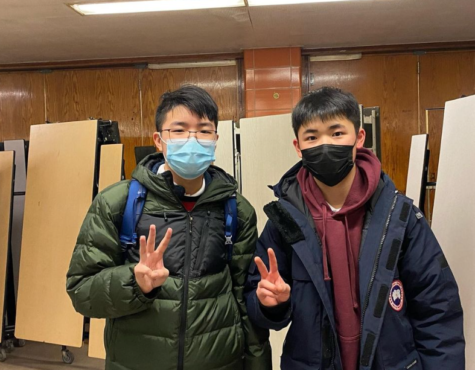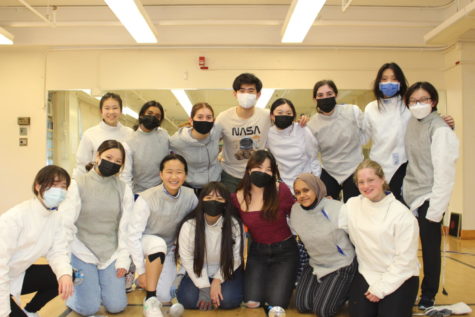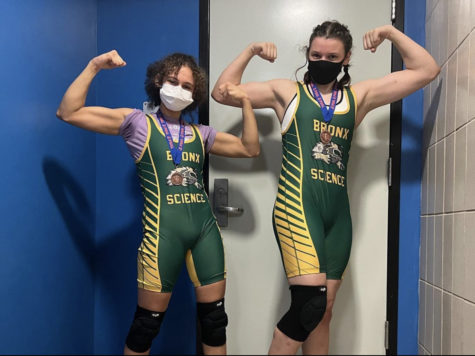The Sports Charm: The Power and Draw of Competitive Athletics
Even in a STEM-specialized high school, there is a powerful draw to participate in sports teams.
Fans by the thousands flock to watch their favorite teams compete, and with science, we can discover why.
The time is seven p.m., Sunday, and televisions are broadcasting the latest football game. People settle on their couches, opening bags of chips or canned beverages. Dinner cleanup begins, with the kitchen tap running in competition with the sports commentator on shift. In another household, teenagers glance up from their phones and homework, pausing their task to watch a play while the pixelated crowd cheers wildly. During commercial breaks, channels are flipped through listlessly, while non-football fans find solidarity within one another.
No matter the sport, there exists an underlying current of connection, a strange bond between one family and another, even from across the world.
There is more to the power and draw of sports than meets the eye. Researchers and sports writers have pursued what makes the average sports fan’s brain tick, digging up new information that alters the way sports writers and psychologists can view the game. Despite not being physically on the field, or even in the same stadium as those professional athletes, watching a sport fires up the “mirror neurons” in our brains, so much so, that it supplies the brain with a deep sense of empathy for the players extending beyond the simple enjoyment of a victory or upset over a loss. A good example of this emotional phenomenon would be inside Yankee Stadium during a Yankees versus Red Sox game, as the nature of the rivalry between teams is quite tense. Mirror neurons are the mechanism in the brain responsible for a fan putting themself in a player’s shoes. And yet, there seems to be an even greater connection that ties certain people to their favorite teams.
The explanation contains layers, though far from airtight. Human brains are highly complex, and therefore take time to puzzle out and pick apart. The world of sports exists beyond our emotions, beyond the constraints of the living room television screen or the bright screens of our phones. “We connect to our teams, to the players on our teams, to the other fans of our teams. We bask in reflected glory because there is some actual point of contact, at the neural level, between a team’s performance and our own self-esteem,” writes author and editorial director Eric Simons in his article, “What science can tell sportswriters about why we love sports”. Humans, a competitive species by nature, tend to stake their pride in events they hold no control over. The practice has become instinctual, understood, and a key necessary component in every sports fanatic. In some manner, the athletes we love and admire are extensions of ourselves, in that their victories become our joyous memories, and their losses take on the form of our sour moods.
At the end of the day, the differences between major-leaguers and people watching from the comfort of their own homes is not all that stark. Perhaps it is simply a part of human nature to identify with others, to unite over events that may seem trivial to an outsider, and to see reflections of ourselves within other individuals.
The Bronx Science Perspective
So how does this tie into our own lives? To start, the Bronx Science athletics community is massive, widely-encompassing, and well established. Many teams have their own Instagram accounts to promote team events and spread the word about their next competition. Garnering support from friends and members of the student body is important, but the athletes have their own goals. And after interviewing Bronx Science athletes, it has become evident that sports is more than just an extracurricular for high schoolers.
There are hundreds of reasons why students are drawn to the sports front, spanning from the appeal of trying something new to following their competitive spirit, doing what they have always known, or pursuing a long-awaited dream. Students come together and forget their differences on the playing field, working drills to iron out any margin for error and preparing for game days. “You’ve got to give it your all for the three points,” said Fredrik Lundquist ’23. Both a tennis and soccer player, Lundquist has experience with multiple styles of teamwork, stating that one of the appeals to sports is working with “the lads.” Whether diving headfirst into the competition spirit, or reuniting with teammates, students are jumping at the chance to get back a shred of normalcy in the wake of the COVID-19 pandemic.
For the ninth grade class, joining a sport provides a great anchor into the community and a good time. “Coming back to school in person for the first time since the beginning of the pandemic, I wanted to fully immerse myself into the high school experience, especially since I was a ninth grader,” said Jadyn Sinclair ’25. “Being a cheerleader and a gymnast before the pandemic, I wanted to try out for the gymnastics team just for the fun of it all.” Athletes like Sinclair were quick to shake off any initial hesitation about joining a sports team, working to regain time lost due to the pandemic. With team rosters filled and athletes united, high schoolers committed their time to practice and games, shouldering a freshly crowded schedule made manageable by the valuable time spent together.

Alexander Wong ’23, an adept athlete, discussed his experience playing sports, and how he manages to juggle school work with the additional time set for games, practice, and outside competitions. Effectively utilizing the opt-out gym policy, Wong finds time here and there to complete his schoolwork, noting that procrastination and a sports-packed schedule is a poor combination. He is proud to be where he stands today, a former badminton team member, broadening his skill set through competing alongside the table tennis and handball teams. His athletic career has undergone significant improvements and changes during his time at Bronx Science, some of his highs including “trying out and making it into the Table Tennis team as a junior (Wong tried out as a ninth grader and didn’t make the cut), coming back from an 0-2 set and winning 3-2 in table tennis with [his] doubles partner, and going out with the badminton and table tennis team for a team dinner,” said Wong.
Victory is the goal for most athletes when competing, and yet it is near-impossible to reach without something stronger. Though skill and practice is essential to progress, putting it all together takes the team. Often, this entails communication building during and outside of the game, post-match celebrations, and practices filled with laughter and friendliness. In fact, the light-heartedness that PSAL sports teams tend to possess is an advantage over the teams streamed around the world. “Playing softball has allowed me to distract myself from school stress, but also form really special friendships in the process. I could not ask for a better way to spend my time,” said Yasmine Salha ’24. As high schoolers, an abundance of pressure already exists for everyone, which means that sports should be an extracurricular activity, something to look forward to and enjoy rather than lament. And through enjoying the time, athletes see improvement in other aspects of their lives. “I’ve made super close friends, and I have people that I can rely on, and it has forced me to improve my work ethic, since I have such limited time. I was able to improve it, because I am much happier, and have much more motivation now,” said Ava Lehmann ’24, teammate to Salha. A downside people often point out about sports is the time consuming aspect, and how such a large commitment can drag down a student’s grades and morale. On the contrary, having a tightly-knit team can lead to improved morale and more academic motivation, while large commitments motivate students to work hard and not waste time.

While the moments of achievement stand out in their own flashy manner, the human connection element is what seemed to stand out the most to the athletes interviewed. “I enjoyed a lot about the sports seasons I played; the people are supportive and I enjoyed the activity, as well as being a part of something I never really had before,” said Haleigh Heubeck ’24, member of the Girls’ Varsity Flag Football team. Students all throughout the school can enjoy playing on their team of choice, from typical high school sports such as baseball and basketball to unique or lesser-known ones such as handball, fencing, and bowling. With the chance to apply oneself to something new, more and more students board the athletics train and gain something priceless. “Because of frequent and long practices along with team goals, you get an almost unique sense of togetherness from sports teams. This aspect is a big part of what makes me look forward to practice and want to really participate as a team member, and I think it really strengthens the team as a whole,” said Antonia Duffey ’24. As a member of the Girls’ Varsity Fencing team, Duffey balances the fencing schedule with debate practice and academic requirements, while making time to participate in PSAL-wide fencing competitions on the weekends. Duffey demonstrated adept time management recently, working diligently with group mates to ensure the completion of important school projects while also attending the PSAL Varsity Fencing Playoffs. Bronx Science emerged victorious, bringing home a PSAL banner and claiming the title of overall first-place champions.

Daniella Lorenzana ’22, co-captain of the Girls’ Varsity Wrestling team and seed three (ranking within the top three) in New York City, agrees. When asked about her favorite memories of the team, Lorenzana replied, “definitely getting food with the team after a big event, because it gives us the opportunity to bond and have a reward for the hard work we put in. It either celebrates a big accomplishment or cheers us up after not getting what we wanted.” Keeping up morale and celebrating alongside teammates improves the overall spirits of all those involved, and it is a great way to form a close group. Most teams have a final team dinner after their season ends, a celebration at a restaurant or even a potluck, but interspersing smaller team gatherings allows teammates to stay relaxed and looking forward to practice. These moments, even more so than grueling practice sessions, are what leave members with memories to look back upon fondly. Lorenzana’s team performed especially well at states, and for co-captain Ariel Ofri-Akman ’22, who secured Bronx Science’s first wrestling state champion, there is sure to be plenty of celebration to come. Congratulations to Ofri-Akman and Lorenzana for their impressive performance at State Championships.
Student athletes work hard, play to win, and build trust and close relationships with team mates. At the end of the day, they pack up their gear and head home, memories and post-practice tiredness fresh on their minds.
When asked about her favorite memories of the team, Daniella Lorenzana ’22 replied, “definitely getting food with the team after a big event because it gives us the opportunity to bond and have a reward for the hard work we put in. It either celebrates a big accomplishment or cheers us up after not getting what we wanted.”
Sam Chin is an Editor-in-Chief and Chief Graphic Designer for ‘The Observatory’ yearbook and a Staff Reporter for 'The Science Survey' newspaper. In...

